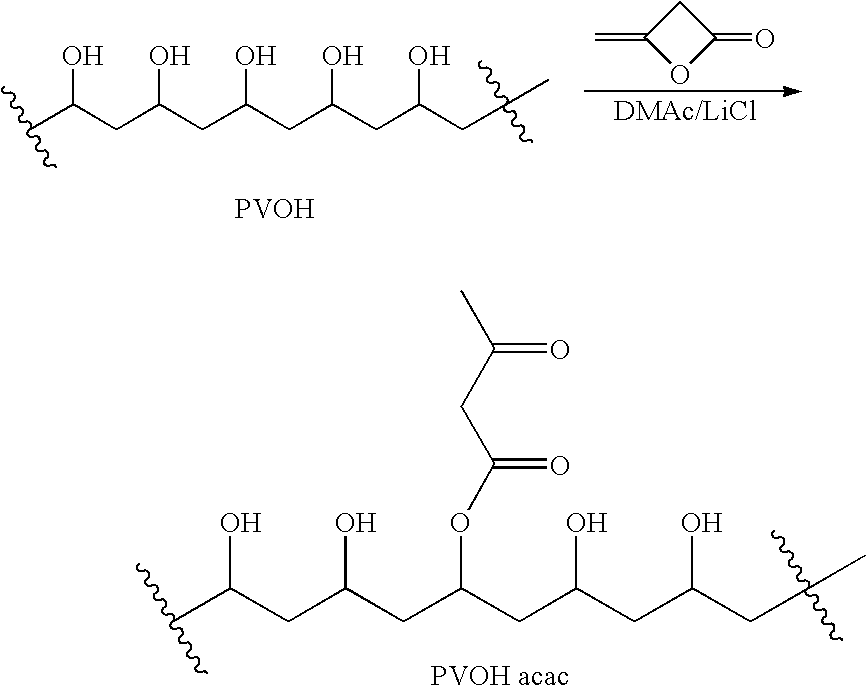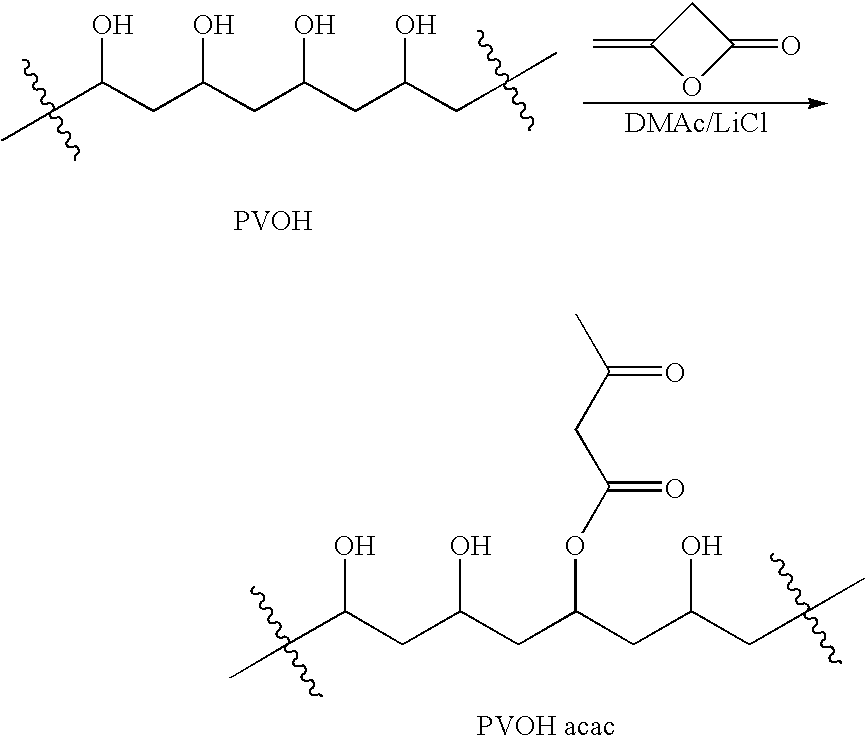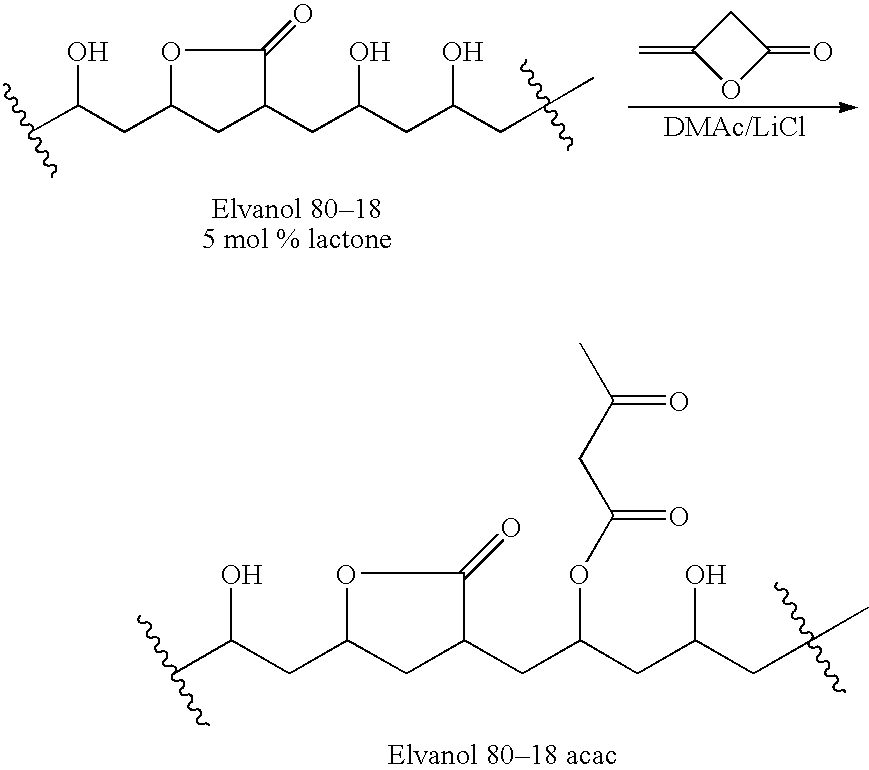Polymer-based tissue-adhesive form medical use
a tissue adhesive and polymer technology, applied in the field of medical adhesives, can solve the problems of limited internal application use of fibrin-based adhesives, inconvenient use of conventional tissue adhesives, slow curing of fibrin-based adhesives, etc., and achieve the effect of preventing adhesion
- Summary
- Abstract
- Description
- Claims
- Application Information
AI Technical Summary
Problems solved by technology
Method used
Image
Examples
example 1
Preparation of Fully-Hydrolyzed Polyvinylalcohol Acetoacetate
[0162]
[0163] 1-A. Polyvinylalcohol (PVOH; Aldrich #36,313-8; 99% hydrolyzed; Mw=31,000-50,000 Da) was dried in the oven with a nitrogen sweep at 70° C. under 350 mm of Hg for 3 days. A weight loss of 3.7% was observed. A mixture of the dried polyvinylalcohol (25.0 g; 570 mmol OH), LiCl (3 g), N,N-4-dimethylaminopyridine (0.10 g) and dry DMAc (150 mL) was stirred in an oil bath maintained at 90° C., in a 500-mL RB flask under nitrogen for 1 hr to give a hazy, colorless solution. The solution was cooled to 70° C. and then stirred as 7.5 mL (8.2 g; 97 mmol) 85% diketene (Aldrich #42,236-3) was added.
[0164] The resulting orange solution was stirred at 70° C. for 2 hr. Then the polymer solution was added with stirring to a mixture of 250 mL methanol and 750 mL acetone in a Waring blender. The solvent was suction-filtered off the fibrous polymer suspension and the polymer was blended with 1 L fresh 1:3 methanol-acetone and the...
example 2
Preparation of 88%-Hydrolyzed Polyvinylalcohol Acetoacetate
[0173] Partially-hydrolyzed polyvinylalcohol (20.00 g; Aldrich #36,317-0; Mw=13000-23000 Da; 87-89% hydrolyzed) was dried for 5 days at 50° C. under 300 mm Hg vacuum with a nitrogen bleed. Weight loss was 5.3% (1.05 g). The 19-g (380 mmol OH) sample was dissolved in 150 mL dry DMAc containing 5 g LiCl along with 100 mg of N,N-4-dimethylaminopyridine in a 500-mL RB flask under nitrogen. The mixture was stirred and heated in a 90° C. oil bath for 1 hr to give a hazy, colorless solution. The solution was cooled to 70° C. and then stirred as 2.9 mL (3.2 g; 38 mmol) diketene was added. The resulting orange solution was stirred at 70° C. for 3 hr and then was added to a mixture of 1 L methanol and 700 mL diethyl ether. The polymer suspension settled and the solvent was decanted off and replaced with 250 mL fresh ether. This was stirred and decanted and replaced with 500 mL fresh ether. The suspension was stirred, decanted and the...
example 3
Preparation of 80%-Hydrolyzed Polyvinylalcohol Acetoacetate
[0175] Partially-hydrolyzed polyvinylalcohol (20.00 g; Aldrich #36,062-7; Mw=9000-10000 Da; 80% hydrolyzed) was dried for 5 days at 50° C. under 300 mm Hg vacuum with a nitrogen bleed. A weight loss was 3.4% (0.68 g) was observed. The 19.3-g (350 mmol OH) sample was dissolved in 150 mL dry DMAc containing 5 g LiCl along with 100 mg of N,N-4-dimethylaminopyridine in a 500-mL RB flask under nitrogen with stirring and heating in a 90° C. oil bath for 1 hr to give a hazy, colorless solution. The solution was cooled to 70° C. and then stirred as 2.7 mL (3.0 g; 35 mmol) diketene was added. The resulting orange solution was stirred at 70° C. for 3 hr and then was poured into 1200 mL acetone. The polymer suspension settled and the solvent was decanted off and the slurry was quickly suction-filtered. The damp cake was washed on the funnel with 500 mL acetone and was then stirred with 500 mL fresh acetone overnight. The suspension wa...
PUM
 Login to View More
Login to View More Abstract
Description
Claims
Application Information
 Login to View More
Login to View More - R&D
- Intellectual Property
- Life Sciences
- Materials
- Tech Scout
- Unparalleled Data Quality
- Higher Quality Content
- 60% Fewer Hallucinations
Browse by: Latest US Patents, China's latest patents, Technical Efficacy Thesaurus, Application Domain, Technology Topic, Popular Technical Reports.
© 2025 PatSnap. All rights reserved.Legal|Privacy policy|Modern Slavery Act Transparency Statement|Sitemap|About US| Contact US: help@patsnap.com



